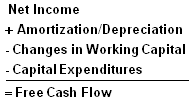By Ben McClure
The cash flow statement shows how much cash comes in and goes out of the company over the quarter or the year. At first glance, that sounds a lot like the income statement in that it records financial performance over a specified period. But there is a big difference between the two.
What distinguishes the two is accrual accounting, which is found on the income statement. Accrual accounting requires companies to record revenues and expenses when transactions occur, not when cash is exchanged. At the same time, the income statement, on the other hand, often includes non-cash revenues or expenses, which the statement of cash flows does not include.
Just because the income statement shows net income of $10 does not mean that cash on the balance sheet will increase by $10. Whereas when the bottom of the cash flow statement reads $10 net cash inflow, that's exactly what it means. The company has $10 more in cash than at the end of the last financial period. You may want to think of net cash from operations as the company's "true" cash profit.
Because it shows how much actual cash a company has generated, the statement of cash flows is critical to understanding a company's fundamentals. It shows how the company is able to pay for its operations and future growth.
Indeed, one of the most important features you should look for in a potential investment is the company's ability to produce cash. Just because a company shows a profit on the income statement doesn't mean it cannot get into trouble later because of insufficient cash flows. A close examination of the cash flow statement can give investors a better sense of how the company will fare.
Three Sections of the Cash Flow Statement
Companies produce and consume cash in different ways, so the cash flow statement is divided into three sections: cash flows from operations, financing and investing. Basically, the sections on operations and financing show how the company gets its cash, while the investing section shows how the company spends its cash. (To continue learning about cash flow, see The Essentials Of Cash Flow, Operating Cash Flow: Better Than Net Income? and What Is A Cash Flow Statement?)
Cash Flows from Operating Activities
This section shows how much cash comes from sales of the company's goods and services, less the amount of cash needed to make and sell those goods and services. Investors tend to prefer companies that produce a net positive cash flow from operating activities. High growth companies, such as technology firms, tend to show negative cash flow from operations in their formative years. At the same time, changes in cash flow from operations typically offer a preview of changes in net future income. Normally it's a good sign when it goes up. Watch out for a widening gap between a company's reported earnings and its cash flow from operating activities. If net income is much higher than cash flow, the company may be speeding or slowing its booking of income or costs.
Cash Flows from Investing Activities
This section largely reflects the amount of cash the company has spent on capital expenditures, such as new equipment or anything else that needed to keep the business going. It also includes acquisitions of other businesses and monetary investments such as money market funds.
You want to see a company re-invest capital in its business by at least the rate of depreciation expenses each year. If it doesn't re-invest, it might show artificially high cash inflows in the current year which may not be sustainable.
Cash Flow From Financing Activities
This section describes the goings-on of cash associated with outside financing activities. Typical sources of cash inflow would be cash raised by selling stock and bonds or by bank borrowings. Likewise, paying back a bank loan would show up as a use of cash flow, as would dividend payments and common stock repurchases.
Cash Flow Statement Considerations:
Savvy investors are attracted to companies that produce plenty of free cash flow (FCF). Free cash flow signals a company's ability to pay debt, pay dividends, buy back stock and facilitate the growth of business. Free cash flow, which is essentially the excess cash produced by the company, can be returned to shareholders or invested in new growth opportunities without hurting the existing operations. The most common method of calculating free cash flow is:
 |
Ideally, investors would like to see that the company can pay for the investing figure out of operations without having to rely on outside financing to do so. A company's ability to pay for its own operations and growth signals to investors that it has very strong fundamentals.
To see more topics on companies and cash flow, read How Some Companies Abuse Cash Flow and Free Cash Flow: Free, But Not Always Easy.
Fundamental Analysis: A Brief Introduction To Valuation
-
 Investing
InvestingAnalyze cash flow the easy way
Learn the key components of the cash flow statement, how to analyze and interpret changes in cash, and what improved free cash flow means to shareholders. -
 Investing
InvestingCorporate Cash Flow: Understanding the Essentials
Tune out the accounting noise and see whether a company is generating the stuff it needs to sustain itself. Learn how to read the cash flow statement. -
 Investing
InvestingCash Flow From Operating Activities
Cash flow from operating activities is a section of the Statement of Cash Flows that is included in a company’s financial statements after the balance sheet and income statements. -
 Investing
InvestingCash Flow on Steroids: Why Companies Cheat
Pressure to be the best can sometimes push corporations to cheat. Learn how they do it and how to spot it. -
 Small Business
Small BusinessUnderstanding Cash Flow
Learn about the different types of cash flows and the importance for businesses to properly manage their cash flows. -
 Investing
InvestingCash flow statement: Analyzing cash flow from investing activities
Here, you'll find an overview of cash flow from investing activities — one of three primary categories in the statement of cash flows. -
 Investing
InvestingHow to Improve Your Cash Flow in Manufacturing
Here are 10 ways to to improve a manufacturer's cash flow.



